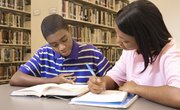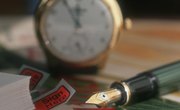Middle school language arts and English teachers, including seventh grade instructors, help students learn to recognize poetic devices, such as imagery and personification, and incorporate them into their own creative writing assignments. Students learn to recognize a wide range of poetic devices and study why poets use them to stress certain content. Teachers should clearly explain and define the different types of poetic devices and provide examples of each.
The Three R's
Teach students how rhyme, rhythm and repetition influence poetry. Rhyme is the repeated use of similar vowel sounds and syllables at the end of a word or verse, such as "Tyger Tyger, burning bright, in the forests of the night" in "The Tyger" by William Blake. Rhythm is the beat or meter of the poem and is often learned by reading poetry aloud. Repetition is the frequent use of the same word or phrase to add impact, such as Maya Angelou's use of "caged bird" and "free bird" throughout her poem "Caged Bird."
Similes and Metaphors
Explain the significance of similes and metaphors so students learn how comparisons make poetry more vivid and easy to relate to. Similes use strong nouns and adjectives to compare or parallel one thing to another, often using "like" or "as" to make the comparison. Jane Taylor did this in the lines of her poem that read, "Twinkle, twinkle little star … like a diamond in the sky." Metaphors portray a person, place or thing as being something else, such as "Hope is the thing with feathers that perches in the soul" in the poem "Hope Is the Thing With Feathers" by Emily Dickinson.
Hyperbole and Exaggeration
Discuss the role that hyperbole, or extreme exaggeration, plays in poetry to make a point. Explain to your students that hyperbole shouldn't be taken literally. For example, in "The Night Has a Thousand Eyes" by Francis Bourdillon, the poet uses a thousand eyes to describe all the stars in the night sky and a thousand eyes to describe all the thoughts in the human mind -- none of which compare to true love.
Personification and Human Characteristics
Explain how poets use personification to attribute human characteristics to objects and animals. Personification makes objects in a poem seem real -- like living entities. For example, in the humorous poem "If Dogs Could Talk" by Denise Rodgers, the narrator describes what dogs might say if they could voice their opinions, desires and emotions.
Imagery and Sensory Details
Tell your students that poets often rely on sensory descriptions -- involving one or more of the five senses -- to explain scenes, people and objects. Imagery helps create a vivid picture so readers visual the setting and the objects or characters. Gary Soto uses sight and sound, such as the crackling of frost on the ground and the burning yellow color of the porch light, to add detail to his poem "Oranges."
Onomatopoeia and Fascinating Sounds
Teach your students the definition of onomatopoeia -- the use of words that sound like what they're describing. Onomatopoeia makes a poem come to life with sounds that add creativity, intrigue and energy. For example, Edgar Allan Poe uses the evocative words "rapping," "tapping," "tinkled," "shrieked" and "flitting" in his poem "The Raven" to add mystery and suspense to his poem.
Related Articles
References
Writer Bio
As curriculum developer and educator, Kristine Tucker has enjoyed the plethora of English assignments she's read (and graded!) over the years. Her experiences as vice-president of an energy consulting firm have given her the opportunity to explore business writing and HR. Tucker has a BA and holds Ohio teaching credentials.











